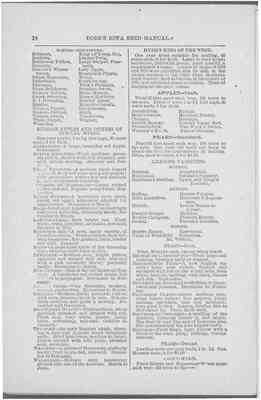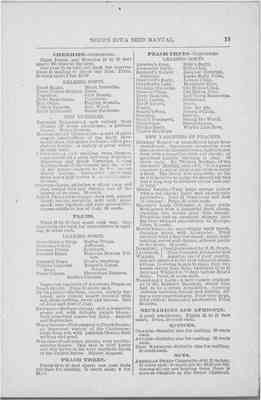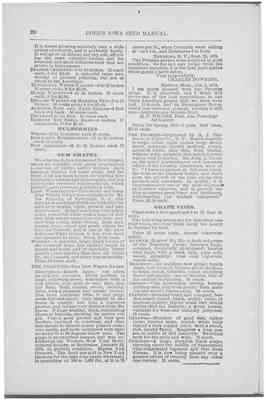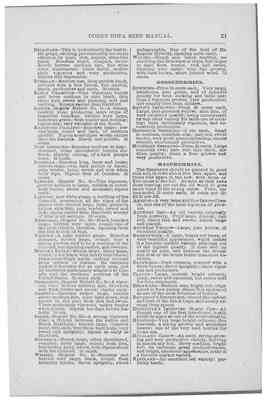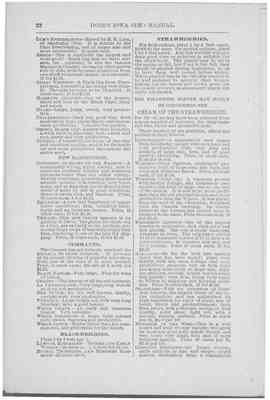Pages
21
18 ... Dorr's Iowa Seed Manual.
[left colum] Winter-Continued. Belmont, Baldwin, Bellflower Yellow, Dominie, Danver's Winter Sweet, Dutch Mignonne, Fallawater, Fameuse, Flora Bellflower, Grimes' Golden, Green Sweeting, R. I. Greeuing, Rambo, Ribston Pippin, Seek-no-further, Talman Sweet White Pippin Wine Sap.
King (Of Tomp. Co.), Limber Twig, Large Striped Pearmain, Lady Apple, Monmouth Pippin, Milam, Northern Spy, Peck's Pleasant, Paradise Sweet, Rome Beauty, Russet Roxbury, Rawles' Janet, Reinette Canada, Smokehouse, Stark, Vandevere, Wagner,
Russian Apples and Others of Special Merit.
One year grafts, 1 to 1-1/2 feet high, 20 cents each: 6 for $1.00. Alexander-A large, beautiful red Apple. September.
Bottle Greening-Fruit medium; greenish yellow, shaded with dull crimson; sub-acid, almost melting. January and February.
Corps' Favorite-A medium sized, dessert apple of deep red color and good quality; very productive; always fair and uniform in size; everywhere desirable.
Duchesse of Oldenburg-Large, striped yellow and red. Popular everywhere. September.
Dutch Butter-A beautiful, even sized, sweet, red apple, admirably adapted for apple butter. December to March.
Haas-Large size; splashed and mottled light red; juicy acid, rich, extremely hardy. November to March.
Lawver-Large, dark bright red. Flesh white, crisp, sprightly, aromatic, sub-acid, January to May.
McIntosh Red-A new, hardy variety, of Canadian origin. Fruit medium, dark red; very handsome, fine grained, juicy, tender and mild, January.
Mann-A good sized apple of the Greening type, keeping until June or July.
Pewaukee -Medium Size; bright yellow, splashed and striped dull red; sub-acid with a rich aromatic flavor; perfectly hardy. December to March.
Red Canada-This is the old Richfield Nonsuch. A handsome red winter apple, but difficult to propagate. December to February.
Sm [illegible] Cider-Very desirable; medium, striped, productive. November to March.
Seedless-Medium sized; greenish yellow, with dark carmine cheek in sun. It is entirely seedless, and quite a novelty. November and December.
Shiawassee Beauty-Fruit medium, white marbled, splashed and striped with red. Flesh firm, very white, tender, juicy, brisk, refreshing, sub-acid. October to January.
Tetofsky-An early Russian apple, ripening in July and August; bears extremely early. Fruit handsome, medium to large; yellow, striped with red; juicy, pleasant acid, aromatic. . Wealthy-A native of Minnesota; perfectly hardy; fruit large, red, sub-acid. December to February.
Walbridge-Medium size; handsome; striped red; one of the hardiest. March to June.
[Right column] Hyde's King of the West. One year trees suitable for mailing 40 cents each; 3 for $1.00. Large to very large; handsome, yellowish green; good quality a remarkable keeper. Apples of crops of 1878 and 1879 were exhibited side by side at the winter meeting of the Ohio State Horticultural Society, held at Canton in December of 1879, and attracted great attention. Time of keeping all the year round.
Apples-Crab. Plant 20 feet apart each way, 108 trees to the acre. Price of trees 1 to l-1/2 feet high, 20 cents each; 6 for $1.00. Aucubifolia. Briar's Sweet. Chicago. Golden Beauty. Transcendent. Whitney's No. 20. Hyslop. Montreal Beauty. Marengo. Powers' Large Red. Van Wyck's Sweet. Yellow Siberian.
Pears-Standard. Plant 20 feet apart each way, 108 trees to the acre. One year old buds cut back to about one foot for convenience in mailing. Price, each 30 cents; 4 for $1.00.
Leading Varieties. Summer. Bartlett. Madelaine. Dearborn's Seeding. Brandywine. Osband's Summer. Tyson and Clapp's Favorite.
Autumn. Buffam. Belle Lucrative. Howell. Swan's Orange. Beurre Clairgeau. Seckel.
Beurre d' Anjou. Duchesse d'Angouleme. Louise Bonne de Jersey. Sheldon. Flemish Beauty. Steven's Genesee.
Winter. Beurre Easter. Vicar of Winkfield. Lawronce. Columbia. Mt. Vernon.
Pears-New. Price, 50 cents each, except when noted.
Beurre De L'Assumption-Fruit large and melting, ripening early in August.
Brockworth Park-A mew English variety; large pale yellow, flushed and streaked with red on the sunny side; flesh white, buttery, melting; very juicy. vinous and rich. September.
Duchesse De Bordeaux-Medium to large; sweet and pleasant. December to February.
Frederick Clapp-Above medium size; clear lemon yellow; fine grained, juicy. melting, sprightly, rich and aromatic; very good to best. Season, October 15th to November 1st. Price, $1.00 each.
Souvenir du Congress-A seedling of the Bartlett, ripening before it, and larger. The fruit is very fine and of immense size, but unfortunately the tree blights badly.
Goodale-Fruit 1arge, light yellow with a blush in the sun; juicy, melting, vinous. October.
Pears-Dwarf. Leading sorts one year buds, 1 to 1-1/2 feet, 30 cents each; 4 for $1.00.
Cherries. Plant Hearts and Bigarreaus 20 feet apart each way; 108 trees to the [illegible].
22
Dorr's Iowa Seed Manual. ... 19
[left column] Cherries-Continued.
Plant Dukes Rnd Morellos 10 to 12 feet apart; 363 trees to the acre. One year from bud, cut back for convenience in mailing to about one foot. Price, 30 cents each; 4 for $1.00.
Leading Sorts.
Black Eagle. Black Tartarian. Early Purple Guigne. Elton. Napoleon. Ohio Beauty. Bell Magnifique. Carnation. May Duke. English Morello. Yellow Spanish. Gov. Wood. Early Richmond. Reine Hortense.
New Cherries Empress Eugenie-A new variety from France of great excellence; a profuse bearer. Price, 50 cents.
Montmorency Ordinaire-A sort of quite recent introdudtion [introduction] of the Early Bichmond class, but larger and later, rnd [and] a prodigious bearer. A variety of great value. 50 cents each.
Juelling-A new seedling from Oregon, supposed to be a cross between Napoleon Bigarreau and Black Tartarian, having the firm flesh of the former and the color of the latter; claimed to be the largest cherry known. Specimens measuring three and a half inches in circumference. 50 cents.
Olivet-Large, globular; a shiny deep red sort, tender, rich and vinous; one of the largest of its class. 50 cents.
Louis Phillippe-Large; dark red, almost black; tender, sprightly, mild acid; stone small; tree vigorous and very productive; ripens middle to last of July. 50 cents.
Plums. Plant 16 by 18 feet apart each way. One year buds cut back for convenience in mailing, 50 cents each.
Leading Sorts. Coe's Golden Drop. Dennison's Red. German Prune. General Hand. Imperial Gage. Italian Prune. Jefferson. Lombard. Magnum Bonum Yellow. Pond's Seedling. Princes Imperial Gage. Reagle's Union Purple. Reine Claude. Shropshire Damson. Smith's Orleans.
Improved varieties of American Plums on Peach Stocks. Price 50 cents each.
De Cradeuc-Medium, round, slightly flattened; skin yellow, nearly covered with red; flesh melting, sweet and vinous. End of June and first of July.
Newman-Medium oblong; skin a beautiful glossy red, with delicate purple bloom; flesh somewhat coarse but juicy. August and September.
Wild Goose-Well adapted to Peach Stocks; an improved variety of the Chickasaw; large deep red. with purplish bloom; flesh melting and good.
Weaver-Fruit large, purple, very prolific; regular bearer. This tree is very hardy and will thrive in the very northern limits of the United States. Ripens August.
Peach Trees. Plants 15 to 18 feet apart; one year buds cut back for mailing, 15 cents each; 8 for $1.00.
[Right column] Peach Trfes [Trees]-Continued. Leading Sorts.
Amsden's June, Alexander Early, Bernard's Yellow Rareripe Crawford's Early, Crawford's Late, Coolidge Favorite, Chinese Cling, Early Beatrice, Early Louise, Early Rivers, Foster, Geo. the 4th, Hale's Early, Hill's Chili, Jacques' Rareripe, Large Early York, Lemon Cling, Mountain Rose, Old Mixon Cling, Old Mixon Free, Red Cheek Melocoton. Richmond, Salway, Scott's Nonpareil, Smock's Cling, Smock's Free, Snow, Steadley, Stump the World, Sturtvant, Susquehanna, Troth's Early, Ward's Late Free, Yellow Rareripe
New Varieties of Peaches.
Bowers' Early-A magnificent large freestone Peach. Specimens measuring over nine inches in circumference, light colored flesh with a beautiful dark red cheek; of excellent quality, ripening in July. 35 cents each. Mr. Thomas Meehan, of the Gardners' Monthly, says of it, "It is a great pleasure to see so large a size with so early a fruit. The flavor was exquisite; so far as it is possible to judge we should say this was a long way in advance of our best early kind."
Beers' Smock-Very large orange yellow with a red cheek; juicy and enormously productive. Last of September and first of October. Price, 35 cents each.
Bilyeu's Late October-A large white flesh peach with a beautiful flush cheek, ripening two weeks later than Smock. Freestone and an excellent shipper, having been shipped successfully to Europe. Price, 35 cents.
Honeywell-An exceedingly early peach, ripening about with Alexander. Fruit medium with a fine red cheek; juicy, half-melting, sweet and vinous; adheres partly to the stone. 35 cents.
Downing, Saunders, Wilder, Seedlings raised by H. M. Engle. They resemble Alexander and Amsden, are of good quality, and are claimed to be very valuable acquisitions. Downing is said to ripen fully two weeks earlier than Hale; Saunders 10 to 12 days and Wilder 8 to 10 days before Hale's Early. Price, 35 cents each.
Marshall's Late-A new variety originated by Mr. Raphael Marshall, which bids fair to be a great acquisition, ripening midway between Smock and Salway, filling a very important gap. Fruit very large, deep yellow; immensely productive. Price 50 cents.
Nectarines and Apricots. A good assortment. Plants 15 to 18 feet apart. Price, 50 cents each.
Quinces. Orange-Suitable size for mailing. 30 cents each. Angers-Suitable size for mailing. 30 cents each. Reas Mammoth-Suitable size for mailing; 50 cents each.
Nuts. American Sweet Chestnut-6 to 10 inches; 10 cents each; 40 cents per 10; $2.50 per 100. Among all our nut bearing trees there is none so valuable as the Sweet Chestnut.
23
20 ... Dorr's Iowa Seed Manual. [left column] It is found growing naturally over a wide extent of country, and is perfectly hardy. It will grow on almost any dry soil, affording the most valuable timber, and the sweetest and most delicious nuts that are grown in this country.
Spanish Chestnut - 6 to 10 inches. 15 cents each; 8 for $1.00. A splendid large nut, worthy of general planting, but not as sweet as the American.
Butternut, White Walnut - 6 to 10 inches 15 cents each; 8 for $1.00.
Black Walnut - 6 to 10 inches 15 cents each; 8 for $1.00.
English Walnut or Maderia Nut - 6 to 10 inches. 20 cents each; 6 for $1.00.
Almonds, Soft and Hard Shells - 2 feet trees cut back. 50 cents each.
Pecans - 1 to 1-1/2 feet. 50 cents each.
Hickory Nut Shell Bark - 6 inches. 10 cents each; 10 for $1.00.
Mulberries White-12 to 15 inches; each 25 cents. Downing's Everbearing-12 to 15 inches; each 75 cents. New American-12 to 15 inches; each 75 cents.
NEW GRAPES We offer the following named New Grapes, which we consider very great acquisitions to our list of hardy, native Grapes. Each has been fruited for some years, and the fruit of all has been before our leading horticultural societies and pomologists, and has universally received commendation, which limited space prevents publishing here.
Lady Washington - This showy and beautiful White Grape was originated by Mr. Jas. Ricketts, of Newburgh, N.Y., who says he is confident it will vie with the Concord as to health, vigor, growth and productiveness. Bunch and berry very large; color, yellowish white with a tinge of delicate pink where exposed to the sun: covered with a thin, white bloom; flesh soft, tender, juicy, sweet and good; ripens before the Concord, and is one of the most delicious White Grapes it has ever been our pleasure to taste. Price, $2.00 each.
Worden - A splendid, large, black Grape of the Concord type, but earlier; larger in bunch and berry, and of decidedly better quality; vine hardier than that old standby, the Concord, and every way as healthy. Price 50 cents each.
The Prentiss - The New White Grape. Description - Bunch large, not often shouldered, compact. Berry medium to large, yellowish green, sometimes with a rosy tint on side next to sun; skin thin but firm; flesh tender, sweet, melting. juicy, with a pleasant and musky aroma; free from foxiness; little, if any pulp; seeds few and small; very similar to Rebecca in quality, but vine a vigerous grower, and foliage very distinct from Rebecca. Foliage healthy, thick, resembling Diana or Isabella, showing its native origin. Vine a good grower and very productive, inclined to overbear, and clusters should be thined [thinned] unless pruned close; vine hardy, and buds uninjured with thermometer 15 to 20 degress [degrees] below zero. The grape is an excellent keeper, and was exhibited at the Western New York Horticultural Society, at Rochester, January 22, 1879, in perfect condition. Ripens with Concord. The fruit has sold in New York markets for the past four years, wholesale, in quantities of 500 to 1,000 lbs., at 15 to 20
[right column] cents per lb., when Concords were selling at 4 to 6 cts., and Delawares 6 to 9 cts.
Newburg, N.Y., Sept. 28, 1878. The Prentiss grapes were received in good condition. So far as I can judge from the specimen bunches, it is the best pure native white grape I have eaten. Very respectfully, Charles Downing.
Boston, Mass., Oct. 2, 1878. I am much pleased with the Prentiss grape. It is excellent, and I think will prove one of the best acquisitions to our white American grapes that we have ever had. It is rich, and its Frontignan flavor, which few varieties possess, renders it still more desirable as a delicate fruit. M.P. Wilder, Pres. Am. Pomological Society. Price, for Spring, 1881 - 1 year, first class, $1.50 each.
The Duchess - Originated by A. J. Caywood, in Ulster Co., N.Y. Bunch medium to large, (often eight inches long) shouldered, compact; berries medium, round, greenish white, skin thin, flesh tender, without pulp, sprightly, rich and delicious; ripens with Delaware. Mr. John J. Thomas, the noted horticulturist and associate editor of the Country Gentleman, says of it: "I have examined, at different times, the fruit of the Duchess Grape, and have seen the growth of the vine on my own grounds and elsewhere. In quality, it is unquestionably one of the most delicious of out-door varieties, and in growth the vine possesses great vigor and hardiness withstanding our winters uninjured." Price, $1.50 each.
GRAPE VINES. Plant rows 8 feet apart and 6 to 10 feet in rows. The following prices are for first-class one year vines, two year vines being too heavy to forward by mail. Price 25 cents each, except otherwise noted.
Agawam, (Rogers' No. 15) - A dark red grape of the Hamburg Cross; bunches large, compact, frequently shouldered; berries very large, with a thick skin, pulp soft, sweet, sprightly; vine very vigorous; ripens early.
Brighton - An excellent new grape; bunch large, well formed; berries above medium to large, round, Catawba color; excellent flavor and quality; one of the best. One of the earliest in ripening. 50 cents.
Croton - Vine moderately strong, berries medium size, yellowish green; flesh melting and sweet; ripens early. 50 cents.
Clinton - Bunches small and compact, berries nearly round, black, pulpy, juicy, of medium quality; ripens some two weeks earlier thad [than] the Isabella; a great bearer, valuable for wine and culinary purposes. 15 cents.
Catawba - Bunches of good size, rather loose; berries large, round; when fully ripe of a dark copper color, with a sweet, rich musky flavor. Requires a long season to arrive at full maturity. Excellent both for the table and wine. 15 cents.
Concord - A large, purplish black grape, ripening about the middle of September; vine remarkabley vigorous and free from disease. It is now being planted over a greater extent of country than any other one variety. 15 cents.
24
Dorr's Iowa Seed Manual. ... 21
[left column] Delaware-This is undoubtedly the best table grape ranking pre-eminently above all others in its pure, rich, sugary, wine-like juice. Bunches small, compact, shouldered; berries medium size, fine wine color, translucent; vines hardy, moderately vigorous and very productive. Ripens 15th September.
Eumelan-Medium size, deep purlish black, covered with a fine bloom, fine quality, hardy, productive and early. 30 cents.
Early Champion-Vine vigorous; bunch and berry medium in size; black, thin skin; pulp sweet and pleasant, soft and melting. Ripens earlier than Hartford.
Goethe, (Rogers' Hybrid No. 1)-A strong, healthy vine, producing large crops of beautiful bunches; berries very large, yellowish green; flesh tender and melting; ripens late; very valuable at the South.
Hartford Prolific-Bunches large; berries large, round and dark, of medium quality. Ripens some three weeks earlier than the Isabella. Hardy and prolific. 15 cents.
Ives' Seedling- Bunches medium to large, compact, often shouldered; berries medium, slightly oblong, of a dark purple color. 15 cents.
Isabella-Bunches long, large and loose; berried large, oval, dark purple or black; pulp tender, juicy, sweet and rich when fully ripe. Ripens first of October. 15 cents.
Lindley, (Rogers' No. 9)-Vine vigorous, berries medium to large, reddish in color: flesh tender, sweet and aromatic; ripens early.
Lady-A new white grape, a seedling of the Concord, possessing all the vigor of the parent vine; berries large, light, greenish yellow, skin thin, pulp tender; sweet and rich; ripens earlier than Hartford; worthy of trial in all sections. 50 cents.
Merrimac, (Rogers' No. 19)-Black, bunches large, berries very large, round; one of the most reliable varieties, ripening from the 10th to 15th of Sept.
Martha-A light colored grape. Bunches compact, berries large, round; vine a strong grower, said to be a seedling of the Concord, but ripening earlier, and sweeter.
Moore's Early-Bunch large, berry large, round; color black with heavy blue bloom; vines exceedingly hardy, entirely exempt from mildew or disease. Its earliness makes it desirable for an early crop, and its hardiness particularly adapts it to Canada and the northern portions of the United States. 75 cents each.
Massasoit, (Rogers' Hybrid No. 3)-A vigorous vine; berries medium size, brownish red; flesh tender and sweet; ripens early.
Rebecca-Bunches rather large, berries above medium size, color light green, rich amber in the sun; flesh rich and sweet. Vines moderately vigorous, rather tender when young. Ripens ten days before Isabella. 50 cts.
Salem, (Rogers' No. 53)-A strong, vigorous vine; a Hybrid between the native and Black Hamburg; berries large, Catawba color, thin skin, free from hard pulp, very sweet and sprightly; ripens as early as Hartford.
Senasqua-Bunch large, often shouldered, compact; berry large, round; flesh firm, but tender, juicy, sweet, rich; ripens about with the Concord. 75 cents.
Wilder, (Rogers' No. 4)-Bunches and berries very large, black, round; flesh tolerably tender, flavor sprightly, sweet
[right column] and agreeable. One of the best of Mr. Rogers' Hybrids, ripening quite early.
WALTER-Bunch and berry medium, resembling the Delaware in color, but larger in size; flesh tender, rich and sweet, ripening very early; vine fair grower, with dark brown, short jointed wood. 75 cents.
Gooseberries
Downing-Price 25 cents each, Very large, handsome, pale green, and of splendid quality for both cooking and table use; bush a vigorous grower, very productive, and usually free from mildew.
Smith's Improved-Price, 25 cents each. Large, pale greenish yellow; skin thin, of very excellent quality, being unsurpassed by any other variety for table use or cooking; bush moderately vigorous, and excessively productive.
Houghton Seedling-15 cts. each. Small to medium, roundish oval; pale red, sweet tender, very good; plants spreading, shoots slender, enormously productive.
Mountain Seedling-Price, 25 cents. Large roundish oval; pale red; skin thick, medium quality; plant a free grower and very productive.
Raspberries.
The Raspberry should be planted in good rich soil, in rows about five feet apart, and three feet apart in the row, with three or five canes to the hill. As soon as they have done bearing, cut out the old wood to give more vigor to the young canes. Price, unless noted, 10 cents each; 50 cents per 10; $3.50 per 100.
Amazon-A very large and fine flavored berry, and one of the most vigorous of growers.
Antwerp Red-An old variety, originally from Antwerp. Fruit large, conical, dull red; flavor rich and sweet; leaves large and plaited.
Antwerp Yellow-Large, pale yellow, of excellent quality.
Brandywine-A large, bright red berry, of very beautiful appearance, which makes it a favorite market variety, althougn [although] not of the highest quality. It does well on nearly all soils, and endures the drouth [drought] and heat of the South better than most varieties.
Catawissa-Dark Crimson, covered with a thick bloom; flavor sprightly; canes vigorous and productive.
Clarke-Large, conical, bright crimson, juicy, sweet and excellent, but rather soft for long shipments.
Delaware-Medium size, bright red; originated in New Jersey, where it is spoken of as one of the most delicious of berries.
Davidson's Thornless-One of the earliest and best ef [of] the Black Caps, and nearly exempt from spines.
Doolittle's Improved Black Cap-Although one of the first introduced, it still holds its place as one of the most valuable.
Herstine-Very large bright crimson; fine flavored; a strong grower and abundant bearer; one of the very best berries for home use.
Highland Hardy-An early, strong growing and very productive variety, thriving in almost any soil. Berry medium, bright red; its earliness, great productiveness, and bright handsome appearance, make it a favorite market variety.
Kirtland-An excellent red variety; perfectly hardy.
25
22 ... Dorr's Iowa Seed Manual.
[left column] Lum's Everbearing-Raised by H. B. Lum, of Sandusky, Ohio. It is similar to the Ohio Everbearing, but of larger size and more productive. 15 cents each.
GREGG-This is decidedly the largest and most prolific Black Cap that we have ever seen, far surpassing in size the famous Mammoth Cluster; averaging when grown side by side, with the same treatment, from one-third to one-half larger. 15 cents each; 10 for $1.00.
Great Western-A Black Cap from Pennsylvania, resembling the Gregg very closely. Thought by some to be identical. 15 cents each; 10 for $1.00.
Mammoth Cluster-One of the largest, latest and best of the Black Caps; juicy and sweet.
Miami-Large, juicy, sweet; very productive.
Philadelphia-Dark red, good size, flesh moderately firm; plants hardy, and enormously productive. Valuable for market.
Seneca Black Cap-Larger than Doolittle, a week later in ripening; firm, sweet and rich, hardy and very productive.
Turner-A beautiful red berry of fine size and excellent quality; said to be the hardiest and most productive throughout the entire west.
New Raspberries. Cuthbert, or Queen of the Market-A remarkably strong, hardy variety, said to stand the northern winters and southern summers better than any other variety. Berries very large, measuring three inches around; conical; rich crimson; very handsome, and so firm they can be shipped hundreds of miles by rail in good condition; flavor is sweet, rich, and luscious. Price, 20 cents each; 6 for $1.00.
Reliance-A new Red Raspberry of superlative excellence; firm, beautiful fruit; hardy and an immense bearer. Price, 10 cents each; 12 for $1.00.
Thwack-This new variety appears to be gaining in favor. The canes are short - 3 1/2 to 4 feet, are as hardy as the hardiest, producing large crops of beautiful fruit; very firm, rendering it one of the best for shipping. Price, 10 cents each; 12 for $1.00.
Currants.
The Currant has not hitherto received the attention its merit demands. It presents us its annual offering of grateful refreshing fruit, just at the same time it is most needed. Price, 15 cents each; the set of 8 sorts for $1.00.
Black Naples-Very large. Fine for wine or jellies.
Cherry-The largest of all the red currants. La Versaillaise-Very large, long bunches, deep red, productive.
Red Dutch-An old, well known, thrifty, upright sort; very productive.
Victoria-Large bright red, with long bunches; late; a good bearer.
White Grape-An early and immense bearer. Very valuable.
White Goindoin-A large, light colored sort; sweet, vigorous and productive.
White Dutch-Milder flavor than the common red, and preferable for the desert.
Blackberries. Plant 3 by 8 feet apart. Lawton, Kittatinny, Snyder and Early Wilson-10 cents each; 3 sorts for 25 cts. Hoosac Thornless, and Missouri Mammoth-15 cents each.
[right column] Strawberries. For field culture, plant 1 by 4 feet apart, 10.000 to the acre; for garden culture, plant 1 by 2 feet apart. Any rich soil that will produce good corn or potatoes is suitable for the strawberry. The plants may be set in the spring or fall, but if set in the fall, they should be planted during September, so as to have them well rooted before winter. When planted late in the fall they require to be well mulched to prevent their winter killing, but the leaves and crown must not be closely covered, as strawberry plants are easily smothered.
The following eleven may justly be considered the Cream of the Strawberries, For 1880-81, as they have been selected from a large number of varieties, for their superior size, flavor and productiveness.
Those marked (p) are pistillate, others are perfect in their flowers.
Longfellow-A magnificent new comer from Kentucky; plants with us robust and very productive; fruit very long and necked, of large size, firm, and of good quality; promising. Price, 10 cents each; S1.00 er dozen.
Warren-Plant vigorous, moderately productive; fruit of large size, fine form and color and delicious flavor. Price, 10 cents each, 12 for $1.00.
Windsor Chief-(p.) A vigorous grower with healthy foliage, and immensely productive; the fruit of large size to the end of the season. It is said to be more profitable than the old standard kinds, and more productive than the Wilson. It was grown from the seed of the Champion, fertilized with the Charles Downing. Its resemblance to the former has caused some to suppose it the same. Price 10 cents each, 12 for $1.00.
President Lincoln-One of the largest berries in cultivation; rich dark color and fine quality. The size is really immense, irregular in form. The originator claims to have measured berries 10 to 11 inches in circumference. It requires rich soil and high culture. Price 10 cents each, 12 for $1.00.
Glendale-So far the best late market berry that has been tested; plant very thrifty, with lall [tall], rank foliage. and very productive; succeeds well on both light and heavy soils; fruit of large size, regular, uniform, conical, bright scarlet color, fair quality; very firm, being fully equal to Wilson in shipping and keeping qualities. Price 10 cents each, 12 for $1.00.
Sharpless-With the exception of President Lincoln, the largest berry of the entire collection, and has maintained its high reputation for vigor of plant, size of berry, flavor and productiveness; flesh firm, sweet, with a delicate aroma, of first quality, color clear, light red, with a smooth, shining surface. Price 40 cents per 10, $2.00 per 100.
Monarch of the West-This is a well tested and truly worthy variety; will grow on most any good soil; stands drouth [drought] and wet; berry very large, firm and of most delicious quality. Price 40 cents per 10, $2.50 per 100.
Crescent Seedling-(p-) Large, conical, quite uniform in size and shape; bright scarlet; moderately firm; a remarkable
